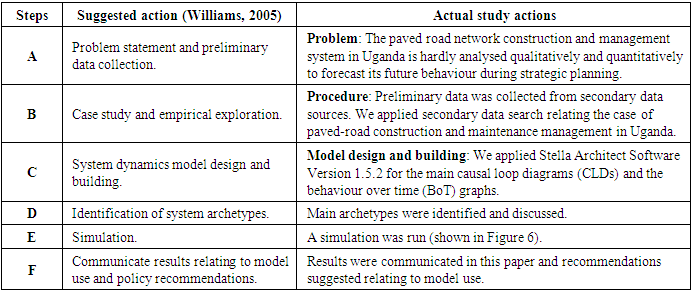-
Paper Information
- Paper Submission
-
Journal Information
- About This Journal
- Editorial Board
- Current Issue
- Archive
- Author Guidelines
- Contact Us
International Journal of Construction Engineering and Management
p-ISSN: 2326-1080 e-ISSN: 2326-1102
2022; 11(2): 31-44
doi:10.5923/j.ijcem.20221102.01
Received: Apr. 14, 2022; Accepted: May 15, 2022; Published: Jun. 23, 2022

A System Dynamics Approach to Support Strategic Planning for Sustainable Paved-Road Infrastructure Management in Uganda
Luyimbazi Godfrey1, Ntwatwa Christopher2
1Works at Kyambogo University as Part-Time Lecturer in the School of Computing and Information Sciences; and is Currently a PhD Student at the College of Computing and Information Sciences, Makerere University, Kampala
2Works with the Office of the Prime Minister as Information Technology Officer in the Refugee Department; and is Currently a PhD Student at the College of Computing and Information Sciences, Makerere University, Kampala
Correspondence to: Luyimbazi Godfrey, Works at Kyambogo University as Part-Time Lecturer in the School of Computing and Information Sciences; and is Currently a PhD Student at the College of Computing and Information Sciences, Makerere University, Kampala.
| Email: |  |
Copyright © 2022 The Author(s). Published by Scientific & Academic Publishing.
This work is licensed under the Creative Commons Attribution International License (CC BY).
http://creativecommons.org/licenses/by/4.0/

Sustainable transport infrastructure and services contribute significantly to the rate of economic growth and improvement of a country's standard of living; and also critical to a country’s competitiveness and ability to harness its regional and globalization potential. However, unlike in the developed economies where a holistic approach is applied for strategic planning and management for sustainable construction and maintenance of the paved-road network, a good number of developing economies where this approach is not applied are challenged on sustainable transport infrastructure development and management. This study aimed at providing a system dynamics model to support holistic strategic planning for sustainable paved-road infrastructure construction and maintenance management with Uganda as a case study. Using secondary data, the study developed a model capable of predicting the behaviour of such a system. The study suggested a number of recommendations most importantly the need to experiment the envisaged system beforehand and base on lessons learnt to make informed decisions and formulate appropriate policies and legislation before actual strategy implementation.
Keywords: System Dynamics, Dynamic Synthesis, Simulation, Strategic Planning, Paved Roads, Uganda
Cite this paper: Luyimbazi Godfrey, Ntwatwa Christopher, A System Dynamics Approach to Support Strategic Planning for Sustainable Paved-Road Infrastructure Management in Uganda, International Journal of Construction Engineering and Management , Vol. 11 No. 2, 2022, pp. 31-44. doi: 10.5923/j.ijcem.20221102.01.
Article Outline
1. Background
- Road transport is one of the most commonly used mode of transport in developing economies; and provides mobility for movement of people, goods and services as well as providing easy access to land and to a wide variety of commercial and social services. The construction of paved roads provides an impressive return on investment as it provides a competitive edge in moving goods economically (Ng et al., 2019).Several studies have shown that the transport sector in countries which are more affluent takes between 6% and 12% of the National Gross Domestic Product (Rodrigue and Notteboom, 2020). In the developing economies this percentage is still low; where according Eijbergen and Thompson (2020), roads in Uganda for example, contribute to only 3% of the country’s Gross Domestic Product (GDP). Madagascar, is one example of a developing economy in Africa where large amounts of money invested in road infrastructure have no apprent economic justification (Wiseman, 2022). Compared to Uganda’s 2040 vision, such a position is untenable for a country that strives to attain middle income status by 2026 (Uganda Media Centre, 2022).The road network, which is part of the transport sector, needs to be well-maintained for it to play an important role in supporting the economic growth of a region (Setianingsi, Sangaj and Setyawan, 2017). It is therefore, necessary to undertake road construction and road maintenance works in the country, to allow for a higher sustainable economic growth. In order to achieve the communication-related development goal as one of the eight global sustainable development goals (SDGs), Uganda’s current transport sector policy, set milestones that need to be achieved in that sector basing on Uganda’s Vision 2040, where, according to the National Planning Authority (2018), the country needs to develop a well-maintained paved-road network to link major cities and other strategic locations in the country. To implement the country’s overall strategy, five-year national development plans have periodically been formulated; beginning with NDPI (2010/2011-2014/2015), NDPII (2015/2016-2020/2021) and NDPIII (2020/2021-2024/2025). One of the key vision strategies is to front-load investments into infrastructure, targeting areas of maximal opportunities with focus on oil, energy, transport and ICT (Uganda National Planning Authority, 2018). In relation to road transport, Uganda Vision 2040 stipulates specific milestones for road development annually (paved-road construction and maintenance inclusive). The government line ministries and other government bodies mandated to implement this strategy, normally formulate five-year corporate strategic plans and periodically write annual budgetary performance reports (as a control measure). Since it is the mandate of the Uganda National Roads Authority (UNRA) to implement the communication development strategic plan for the country’s national roads, UNRA’s corporate five year strategic plan of 2017-2023, acknowledged that roads which had not been done were below the target of 2040. Positive contribution is though assessed basing on the availability of a good paved-road network. Looking at Uganda’s statistics, the number of kilometers of unpaved roads is far higher than that of paved roads; which affects the country’s GDP. Uganda thus spends considerable sums on road development and maintenance. According to UNRA’s annual report 2019-2020; a funding shortfall had accumulated a maintenance backlog of up to 3,500km, an equivalent of 33% of the planned 11,000km of paved national roads for the financial year 2019-2020. By the year 2021, the government had tarmacked a total of 8,588km of roads (national roads inclusive); which translated to an average of 252km of paved roads per year (Uganda National Road Authority, 2021). According to the integrated transport infrastructure and services program performance report of the Ministry of Transport and Works, for financial year 2020/2021, the total paved stock of the national road network by the end of the financial year, stood at 5, 591km with 96.6% of paved national roads in fair-to-good condition.
|
2. Literature Review
2.1. Understanding Paved-Road Construction and Maintenance Management
- The transport sector, combined with other socio-economic factors (such as exports, education, physical capital stock and urbanisation), plays an important role in ensuring economic growth specifically through infrastructure development. Road infrastructure development provides mobility for efficient movement of people, goods and services as well as provision of a wide variety of economic and social activities that include improved access to markets, social services, employment, reduction of transportation costs and travel times (Akinradewo et al., 2020). Despite the benefits of road infrastructure developments, the lack of holistic planning for road construction and maintenance, creates a number of challenges. These challenges result into operations being carried out in fragments; for instance, using conflicting components with inefficiency, which normally would lead to wastage and inability to make proper plans. This in turn hampers development.Mahamid, Bruland and Dmaidi (2012), investigated the causes of road construction project delays through a detailed literature review. They concluded that average time-overruns were the major causes of road construction delays. On top of time-overruns, other causes of delay included the political situation, inappropriate designs, natural disasters, poor road inspections, progress payment delays and poor ground conditions. As much as the authors identified the problems associated with delays in road construction, their research did not study any operations systemic structure associated with road infrastructure development. This would render their conclusion on time-overruns as the major causes of road construction delays questionable; since all the factors that interplay were not analysed from a systemic perspective.Muhwezi, Basoona and Acai (2021), note the lack of road network sustainability maintenance management as the second most important cause of road accidents in Uganda. However, road maintenance management begins with road maintenance planning. Road maintenance planning includes prediction of road deterioration. Road deterioration is one of the factors to be considered in road maintenance planning, which is part and parcel of road infrastructure development. Marović et al. (2018), developed a model that could predict road deterioration. This model would serve as a tool for road maintenance planning activities.Unfortunately, both road maintenance and road deterioration were not looked at from a systemic perspective by these studies; which would have enabled the identification of leverage points that would need to be addressed to improve sustainable road maintenance management in relation to road deterioration.Policy & Fazekas (2018), identify large amounts of public funds that go into transport infrastructure development of complex projects. These complex projects are comprehensible to a few experts and are a primary target for experts who are corrupt. Corrupt tendencies are more widespread in developing economies, leading to effects like increase in costs; and low-quality road infrastructure. Their study concludes that countries that heavily invest in transport infrastructure and that put more emphasis on corruption management are the ones able to realize value for money by putting in place early intervention and corruption preventive measures. Their study however, did not make a systemic analysis on the relationship between corruption and sustainable paved-road construction and maintenance.Welde & Odeck (2017), investigated causes of cost overruns in the planning phase of road projects. They discovered that there could be inaccuracies relating to cost estimation during the front-end phase of planning the project. If the costs estimated at the front-end phase were not accurate, this would lead to wrong projects being selected. This would also raise issues on accuracy of information that was based on to estimate project costs. Using secondary research consisting of 42 Norwegian road projects, the study identified project ownership during the front-end phase of project planning, as the major cause of cost overruns. The study however, did not demonstrate how project ownership would be responsible for cost overruns from a systemic perspective; which would have identified possible leverage points and bottlenecks that needed to be addressed to explain how cost overruns relate to project owners.
2.2. Application of System Dynamics in Road Infrastructure Construction and Maintenance
- System Dynamics (SD) is an approach that assists in enhancing learning in complex systems. It was first introduced by Jay Forrester in the 1950s from the Massachusetts Institute of Technology. This method has been widely used to study behaviours of operations systems. System Dynamics helps in understanding the dynamic and other complexities within an operations system. To understand the complexities in operations systems, there is need to apply various methods, tools and techniques. The most common methods and techniques applied include i) Causal loop diagrams (CLDs), ii) System archetypes and iii) Stock and flow diagrams. CLDs are used to map components/variables within a given operations system. A stock and flow diagram represent a calculable graphical representation of an operations system. System archetypes are a set of classic stories of problems or behaviours that occur often or widely in many situations and across a broad range of organisations. These stories have a distinctive theme and a particular pattern of behaviour which can be graphed on a behaviour over time (BoT) graph; and particular components and variables which can be mapped on a causal loop diagram (CLD). The transport sector, specifically relating to paved-road infrastructure construction and maintenance management, is an operations system where maintaining the system involves a complex array of interconnected activities which have dynamic complexity and combinatorial complexity. This system is characterized by non-linearity, causal loops and feedback loops, in the sense that building and managing a sustainable paved-road infrastructure network in a country, would normally involve dynamic and combinatorial complexity. The complex nature of managing paved-road infrastructure construction and maintenance therefore, provides a challenge for policy makers to make correct policy interventions for sustainable paved-road network infrastructure construction and maintenance management. The structural and behavioural nature of the paved-road infrastructure construction and maintenance system, can better be studied and understood using system dynamics.System dynamics modelling methods have been widely used to study, understand and propose policy interventions in the transport sector. For instance, Xue et al. (2020), used system dynamics (SD) theory to develop a transit metropolis simulation model using four subsystems: economy, society, environment and transportation supply and demand; to promote sustainable development of urban transportation for a rapidly developing economy, society and urbanization. The study involved investigating the effects of transit metropolis construction for a growing economy of Nachang City in China. Setiawan, Indarto and Deendarlianto (2019), used SD theory to propose improvement in road transportation sector policy formulation as an effective strategy for reduction of energy consumption and carbon dioxide emission (CO2). SD was used to forecast energy demand and CO2 emissions based on past and relevant data. Their study also identified and highlighted key challenges that needed to be addressed by providing insights into plausible alternative future transport demand realities. The results of their study indicated that the use of a policy mix scenario is able to provide a higher reduction of oil consumption of up to 41% and CO2 emissions of up to 12% by 2050; unlike using a single scenario with 26% for oil consumption and 7% for CO2 emissions.
2.3. Theoretical Underpinning of the Study
- This study was based on the dynamic synthesis methodology (DSM) proposed by (Williams, 2005); which aids in empirically explaining and predicting the behaviour of a complex system. In this case, the system under focus related to paved-road infrastructure construction and maintenance operations in Uganda. Rwashana et al. (2014) and Williams (2005), note that DSM integrates theoretical concepts and structural parts and elements of a process over time in such a manner to form a formal functional entity, underpinned by synthesis. This is achieved by combining two research strategies: application of qualitative techniques and application of quantitative techniques. These scholars note that DSM has six stages namely i) problem statement and preliminary data collection; ii) field studies; iii) model building; iv) case study and empirical exploration; v) simulation; and vi) policy analysis. All these stages combined assist in improving both building and testing theories in understanding business processes and strategic modelling and analysis. DSM allows for theoretical grounding and well-structured methods for effective data collection. Data collected can be objectively represented in the System Dynamics (SD) model containing mathematical formulas with numerical values of various parameters. This contributes to enhanced understanding of business process problems from a dynamic feedback control point of view; and it also allows for collection of data about a phenomenon and then experiment with the data collected and entered into the model; in order to predict the behaviour with what if dynamic analyses.Kizito and Ssemwanga (2020), carried out a study in which they applied the first three stages of DSM (problem statement and preliminary data collection, field studies; and model building). Their study focused on road accident prevention by considering the linear interactions and non-linear interactions of variables during the pre-crash phase. They developed a model that allowed understanding the factors associated with road accident causation.
2.4. Conceptual Framework for the Paved-Road Network Construction and Maintenance Management Operations System in Uganda
- To explain the conceptual framework of this study in Figure 1, existing policy, rules and regulations relating to the paved road network construction and maintenance management system, do influence the budgetary allocation to funding road construction and road maintenance works.
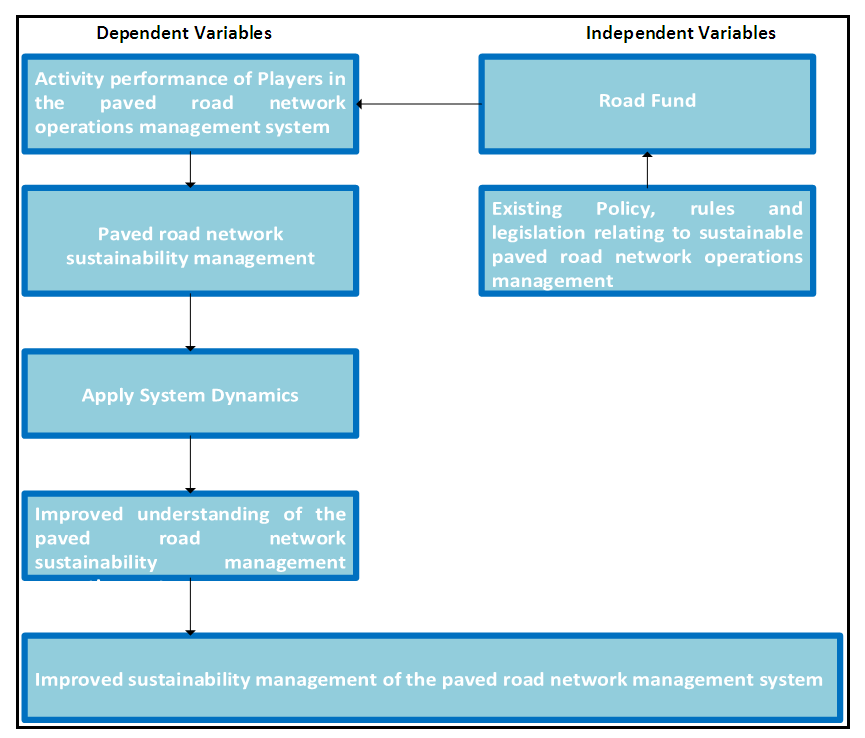 | Figure 1. Conceptual framework of the study |
3. Methodology
- The dynamic synthesis methodology (DSM) with slight modifications in the steps, was followed to study the complex system of the paved-road infrastructure construction and maintenance operations system. The study went through the following: problem statement and preliminary data collection, field studies (in form of literature search); model design and building; identification of archetypes, simulation, communication of results and suggestion of recommendations. Two research strategies were thus used namely: secondary data research and system dynamics. Secondary data research involved using existing data that had already been summarised and collated in various publications. This data was collected from authoritative published academic research reports; as well as authoritative documents available from various non-academic sources like government and non-government agencies. The use of secondary data was justified on the basis that such data too, according to Johnston (2014); offers the same basic principles as studies utilising primary data. Data collected from these sources were objectively represented in the system dynamics (SD) model containing mathematical formulas with numerical values of various parameters.
3.1. Methodological Procedure
|
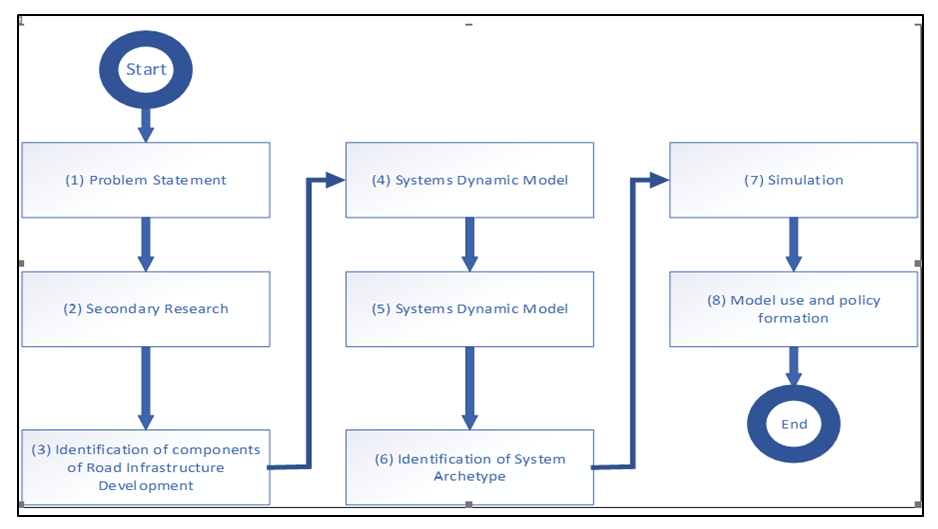 | Figure 2. Methodological procedure followed to conduct the study for paved-road network |
4. Findings
4.1. Understanding the Problem Structure
- The study focussed on Uganda’s transport sector, specifically the road sub-sector. The road sub-sector’s contribution to Uganda’s GDP was 3%. However, unpaved roads and poorly maintained paved roads, were leading to accidents that cost the country 5.8% of the country’s GDP. According to Setianingsi, Sangaji & Setyawan (2016), in order to support economic growth, the road network in an economic region needs to be maintained. According to Ggoobi, Lukwago and Bogere (2020), the road sector in Uganda faced the challenge of corruption, which according to the World Bank, accounted for as much as 5%-20% of transaction costs. This resulted into increased costs of construction. For example, the Entebbe Express Highway in Uganda is estimated to have cost 9.27 million dollars per kilometre. This was assumed to be the most expensive road among developing economies; a strong signal that corruption is a liability to the county. This high cost in terms of capital and recurrent costs, could have been avoided if corruption were addressed. Nevertheless, the more new roads constructed without maintaining them, the more this would lead to adverse effects and injuries resulting from road crashes which eat up twice the transport sector’s contribution to GDP (UNECE, 2018). According to the UNRA’s annual report 2019-2020, the funding shortfall had accumulated a maintenance backlog of up to 3,500km which was an equivalent of 33% of the planned 11,000km of paved roads for the financial year 2019-2020. This imbalance resulted into unsustainable construction and maintenance of the paved-road network. The same report talks about the low budgetary allocation to road maintenance which can only cater for 47.3% of the annual road-maintenance needs. It is also reported that environmental conditions like rain and over flooding in low land areas, normally lead to accelerated road deterioration and finally to increased accidents.Uganda national road network condition by June 2020, put the condition of good paved roads at 52%, leaving accumulation of a big portion of roads requiring urgent periodic maintenance and rehabilitation. Figure 3 demonstrates a rapid decline of good roads from 2018-2019 to 2019-2020.
 | Figure 3. Condition of paved national road network for June 2020 (An extract from UNRA Annual Report 2019-20) |
4.2. Causal Loop Diagram for Paved-Road Construction and Maintenance Management System in Uganda
- Figure 4 below represents the problem structure of Uganda’s paved-road construction and maintenance operations system.
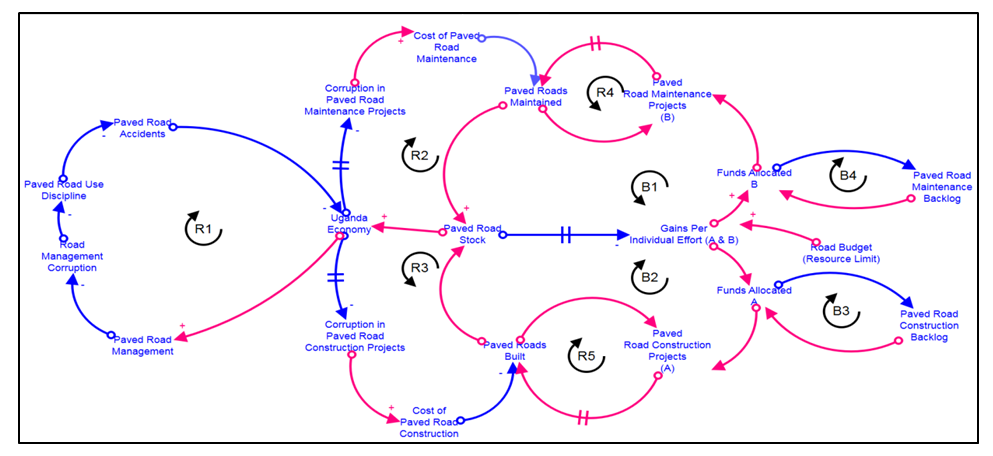 | Figure 4. Causal loop diagram of the problem structure relating to paved road construction and maintenance in Uganda |
4.3. Stock and Flow Diagram Depicting the Quantitative Analysis of Uganda’s Paved-Road Construction and Maintenance Management Operations System
- The stock and flow diagram in Figure 5 below, provides an explanation of the inflows and outflows relating to paved-road construction and maintenance management operations. Road construction starts with new roads initiated (Road Initiation) in form of a flow. After Road Initiation, the roads go into the stock of Paved Roads Under Construction (this assumes both new roads being paved and paved roads undergoing maintenance works).
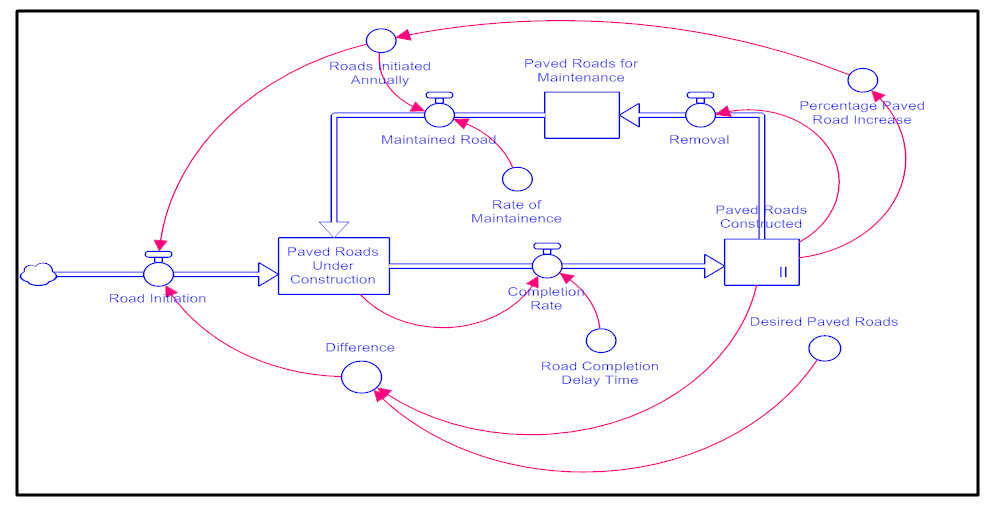 | Figure 5. Stock and Flow diagram of paved-road construction and maintenance operations (constructed using Stella Version 1.5.2) |
4.4. Behaviour over Time Graph Depicting the Trend of Paved-Road Construction and Maintenance in Uganda from 2021-2040
- Based on available literature, the graph in Figure 6 is a simulation of the stock of Paved Roads Constructed and stock of Paved Roads for Maintenance in the country by 2040, if the road construction and maintenance operations system continues to operate as the case was in 2021.
 | Figure 6. Behaviour over time graph on the trend of paved-road construction and maintenance in Uganda up to 2040 |
4.5. Identification of System Archetypes
- Basing on this study, the paved-road construction and maintenance management operations system in Uganda can be associated with three archetypes namely: Tragedy of the Commons, Fixes that Fail and Shifting the Burden. Figure 4 indicates processes that relate to the Tragedy of the Commons, apparently the overriding archetype. This archetype is the root cause of the other two archetypes namely: Fixes That Fail and Shifting the Burden; that the road construction and maintenance sub-sector in Uganda is currently experiencing. R4 in Figure 4 relates to the Tragedy of the Commons archetype. The country’s top management (especially Parliament), normally decides the percentage budgetary allocations to different sectors of the economy. Apparently, decision to allocate resources to paved-road construction and paved-road maintenance does not consider the overall effects, which finally lead to the Tragedy of the Commons. The story behind this archetype is that the country’s top management - in this case the Parliament of the Republic of Uganda – is mandated by law, to decide the percentage budgetary allocations to road construction and maintenance in the country. More often than not, decision to allocate resources to road construction and road maintenance, depends on the political ambitions within top management. For example, in the 2019/2020 budget, the political agenda was to construct more paved roads in the country. Finally, 90% of money budgeted for the transport sector went to the construction of new paved roads. Only 7% went to road maintenance.Resource allocators rationally allocate budgetary resources with good intentions. However, they normally do not have a clear idea of the overall effect on the entire road network management system in the country. Consequently, the paved-road sustainability maintenance management suffers underfunding. Paved roads constructed imply a net gain for the Directorate of Works in the line ministry. Paved roads maintained in the country would equally imply a net gain for the Directorate of Maintenance in the same line Ministry. The more paved roads the Directorate maintains, the more the net gain for the Directorate. This would in turn lead to improved paved-road maintenance. The higher the stock of paved roads maintained, the more this activity adds to the stock of good paved roads. But because of the budgetary resource limits, there builds a paved-road maintenance backlog. This backlog in financial year 2014/2015 stood at USD 802.4 million (Ministry of Works and Transport, 2015). The NDP II by 2020 was targeting an annual rate of construction of 520km of paved-road; however UNRA was only able to achieve an equivalent of 329km per year; and out of the 22 NDP II core road projects, only 09 projects were by 2020 on schedule, leaving 13 projects as backlog. That underperformance was largely attributed to financial constraints (Ggoobi, Lukwago & Bogere, 2020). R5 in Figure 4 also indicates a reinforcing process relating to the Tragedy of the Commons archetype. When the Directorate of Works gets money, it invests that money in road construction projects. This in turn increases the number of paved roads constructed. But because of the budgetary resource limit every financial year, a paved-road construction backlog builds up due to underfunding; where, for example, the more the paved-road construction backlog builds up, the less the Directorate of Works gains from each road construction project. When elements within top management prefer more financial resources to be allocated to new paved-roads, the Directorate of Maintenance in the line ministry suffers. Resource allocators would rationally allocate the resources to paved-road construction, without considering the overall effect on the overall paved-road network. Paved roads maintained in the country imply a net gain for the Maintenance Department. The more paved roads the Directorate maintains, the more the net gain for the Directorate of Maintenance. This would in turn lead to improved paved-road maintenance. When the Road Maintenance Directorate gets money meant for road maintenance, it invests it in road maintenance projects. This adds to the stock of good paved roads. But because of the budgetary resource limit, there is a paved-road maintenance backlog that builds up. This is basically due to underfunding. B1 and B2 in Figure 4 are balancing processes relating to the Tragedy of the Commons. B3 and B4 are balancing processes outside Tragedy of the Commons loops. These processes maintain a balance between backlog and funds allocated for both road construction and road maintenance. The Directorate of Works competes for the road budget to construct paved roads. It improves the paved-road stock in terms of good paved roads. But because of the budgetary resource limit, gains per road construction project implemented decrease, for the budget resource is limited. When the total activity of projects in both directorates exceeds the budgetary resource limit, the common resource (the finances allocated to the road sub-sector) is continually eroded. To solve the Tragedy of the Commons, there is need to identify motivators that drive the individual reinforcing processes. In this case, each department has different priorities. There is need to determine the time frame in which each one of the directorates realises its gains. Then the time frame can also be determined when the road budget will be depleted. Policies that help the two directorates to determine a long-term impact on the common budget, have to be formulated. Long-term goals can only be identified by simulation based on a stock and flow diagram to determine the optimum amount of budgetary allocation per directorate. In line with that, this study also proposes that the Uganda Government ought to take the actions that avoid occurrence of the Tragedy of the Commons in Uganda’s road sub-sector. Such actions may include the following: community awareness, government as a final mediator, cooperation and cost-sharing, insurance and local management of the commons - where in such cases local councils (especially when the parish model is fully operational in the country) - must be given responsibility to ensure that funds for road construction and maintenance in their administrative area are not embezzled by technocrats in road construction and road maintenance; and that such funds are spent rightly and meaningfully. This should be emphasised in the parish model government is keen on implementing.Another archetype noted was the Fixes that Fail archetype. Figure 7 below, indicates the generic structure of the Fixes that Fail archetype on the left hand side; and on the right hand side the figure indicates how the archetype relates to Uganda’s situation in relation to paved-road network maintenance management.
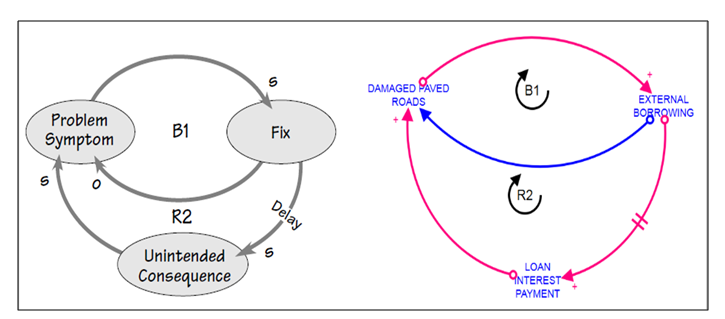 | Figure 7. Fixes that Fail archetype relating to paved-road maintenance management |
 | Figure 8. Shifting the Burden archetype relating to paved road maintenance |
5. Conclusions
- This study revealed that the lower the paved-road maintenance budget, the higher the deterioration rate of good paved roads and consequently the futility of putting more emphasis on construction of new paved roads and less emphasis on maintenance of existing paved roads; since the stock of paved roads due for maintenance steadily continues to rise over and above the paved roads constructed. This study discovered that Uganda’s road budget, especially for road maintenance activities, was far below the level required to achieve the desired stock of the envisioned kilometers of a well maintained paved road network by 2040. Apparently the country is on course to achieve its target of tarmacking 80% of its 21,000km national road network by 2040 in line with the Vision 2040 (Uganda National Road Authority, 2021). However, in spite of that, this study revealed that Uganda cannot achieve a sustainably well-maintained paved road network by the year 2040, because many paved-roads shall be due for maintenance over and above those constructed as the graph in Figure 6 indicates. Looking at the current statistics, Uganda could predictably not achieve its target of 2040 for a well maintained paved-road network stock.This is because a good number of paved roads due for maintenance would still be in stock of roads due for maintenance. The problem this study noted was continued underfunding of paved-road maintenance works; without striving for a balance in relation to funding for paved-road construction. In other words, government is constructing more paved roads than it can sustainably maintain.
6. Discussion of Results
- The dynamic synthesis methodology (DSM) applied in this study, employs qualitative and quantitative techniques to understand the complex nature of the paved-road construction and maintenance operations system under study. The study made use of Stella software Version 1.5.2. The causal loop diagrams helped to demonstrate how the various variables and components within the system interact with each other. The stock and flow diagram in Figure 5 presents the relevant stocks and flows within Uganda’s paved-road construction and maintenance system. The simulation in Figure 6 presents Uganda’s projected goal of 2040 in relation to paved-road network construction and maintenance. From the analysis, the low budget allocated to road maintenance seems to be the main cause for unsustainable construction and maintenance of a well-maintained paved road network in the country. The results indicate that there will be more paved roads due for maintenance than those constructed if low budgetary allocations to paved-road maintenance works continue.
7. Summary and Recommendations
- The study used system dynamics modelling to demonstrate the inter-connectedness of various factors in paved-road construction and maintenance management. The implications for the road network sub-sector in relation to the model presented in this study, are that analysing each one of the variables that interplay in relation to the paved road network construction and maintenance management, influences paved road maintenance policy; and clarifies the problem areas that need to be tackled. If these variable factors are well highlighted, this would inform the paved-road construction and maintenance authorities and policy-makers concerned to act appropriately and choose their priorities right; when making decisions relating to paved-road construction and maintenance management decisions. This study recommends that policy and decision makers within the paved-road construction and maintenance system should always carry out a small experiment to get advanced knowledge and understanding of how the system may behave in future so that the decisions they take are informed by that experiment and forecast. Authorities would then base on lessons learnt from the experiment and be in position to formulate appropriate policies, rules, regulations and legislation informed by scientific analysis; because mistaken mental models that planners in the road sub-sector may base on, may possibly lead to wrong decisions relating to the management of the paved-road network construction and maintenance operations management system. Therefore, strategic planners for the paved-road construction and maintenance system in Uganda, should first and foremost run simulations of various strategic alternatives in light of various constraints, in order to predict the likely behaviour of such a system over time; and then come up with informed decisions on what would appear to be the best alternatives to implement and how best to allocate funds for both paved-road construction works and paved-road maintenance works. This would call for UNRA as a major stakeholder, to improve its road asset management system (RAMS), by incorporating a systems dynamics approach to strategic decision-making on various key issues before the strategic decisions for the paved-road construction and maintenance strategic plan are implemented. For example, currently only 7% of the budget for road works goes to road maintenance and whopping 90% of the budget is allocated to road construction which would cause an imbalance between road construction and road maintenance. The basis of such a decision would be quite debatable and questionable. In addition, according Afrawee, Aodah and Mohammed (2020), the essential need for reviewing, assessing and maintaining roads requires continuous provision of funds. The URF account to which Uganda Revenue Authority (URA) must remit money, should not be idle due to failure by URA to remit money to that account just because of a quark in the URA legislation. This implies that there would be need to amend Section 14 of the URA Act (1997), to allow the authority to directly transfer road user charges (RUCs) to the URF. This account, if loaded with good money, would ensure adequate funding for road maintenance works and reduce the paved-road maintenance backlog. In the same vein, if equal attention was paid to the development and maintenance of the rural roads in Uganda, there would be sufficient, safe and reliable physical access to social services as well as reduced travel time that would be used for wealth creation (Muhwezi, Basoona and Acai, 2021).Government therefore, needs to revise policies that seemed not to be working well; for example, the 2012 policy relating to changing from contracting road maintenance works to use of Force Account. The Force Account policy in the Ministry of Works and Transport (MoWT) was apparently not working well for the benefit of sustainable paved-road construction and maintenance. As a matter of policy, advisably road construction and road maintenance contractors had to standardise road construction and maintenance, section-by-section. In addition, there was need as a matter of policy, to have in place databases documenting the following: a) Roads for Paving b) Roads Under Construction c) Roads Paved d) Paved Roads_due_for Major_Maintenance_Works. Again as a matter of policy, the database table relating to Paved Roads_due_for Major_Maintenance_Works, would ideally include the following fields:-[Section: e.g. Kampala-Kibuye Section]. [Date_of_Last_Major_Maintenance_Works_Completion: e.g. 2020]. [Date_Due_for_Next_Major_Maintenance_Works_Commencement: e.g. 2025].Other databases could contain information relating to roads due for paving, roads undergoing paved construction and new roads paved to completion. Such information ought to be available in the public information domain; more so that the country subscribes to democratic governance and envisages a parish model of administration and governance. Money allocated for paved-road sections due for construction and those roads due for maintenance ought to be published in the public information domain so that those responsible to execute government programmes would be held accountable by the public. Paved-road construction and maintenance costs and projects ought also to be subjected to public scrutiny. The study also recommends that the Uganda Association of Civil Engineers professional body ought to be incorporated in the construction and maintenance of paved roads; especially to scrutinise and monitor paved-road construction and maintenance works. These works would then be approved by the professional body; so that there would be assurance that paved roads constructed and paved roads maintained do conform to national and international engineering standards from a professional point of view. This would be one way of fighting corruption; and minimize shoddy work in road construction and maintenance works.
 Abstract
Abstract Reference
Reference Full-Text PDF
Full-Text PDF Full-text HTML
Full-text HTML
